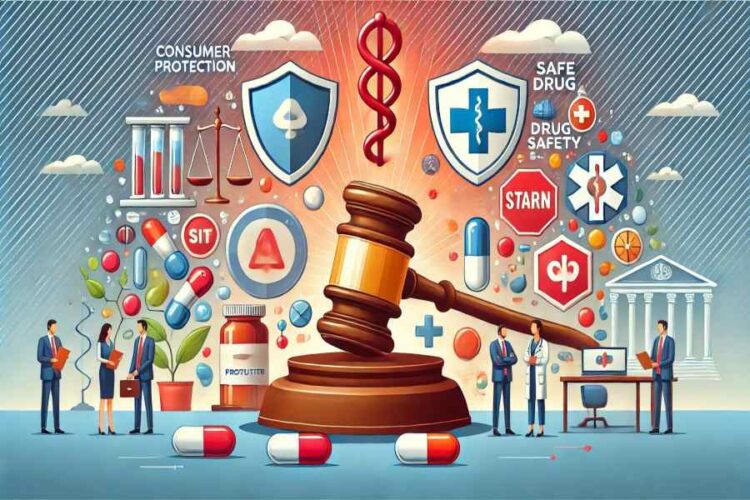When it comes to consumer protection, pharmaceutical lawsuits play a crucial role. These legal actions often arise when consumers suffer harm from medications, prompting scrutiny and accountability from drug manufacturers. The Federal Trade Commission recently highlighted concerns over potentially deceptive ads related to these lawsuits, suggesting that some ads might mislead consumers about the safety of their prescribed medications.
Understanding how these lawsuits impact consumer protection becomes even more crucial when considering cases like the Ozempic lawsuit, which highlight significant legal challenges faced by patients who experience adverse effects from medications: https://www.drugdangers.com/ozempic-lawsuit/.
Understanding how these lawsuits impact consumer protection becomes even more crucial when considering cases like the Ozempic lawsuit, which highlight significant legal challenges faced by patients who experience adverse effects from medications.
Overview of Pharmaceutical Lawsuits
Pharmaceutical lawsuits play a crucial role in ensuring consumer safety and holding drug manufacturers accountable. These legal actions often drive significant changes in industry standards and regulations.
The Role of Lawsuits in Consumer Protection
Lawsuits against pharmaceutical companies serve as a critical mechanism for consumer protection. They shine a light on harmful practices, compel companies to comply with regulations, and ensure that consumers receive safe medications. Personal injury attorneys, who specialize in these cases, perform rigorous legal research and gather substantial evidence to support their clients’ claims. This legal scrutiny helps enforce drug safety standards and mandates transparency within the industry.
Examples of Significant Cases and Their Impact
Several high-profile cases have highlighted the importance of pharmaceutical lawsuits in protecting public health.
- California v. Purdue Pharma (2014): This case involved claims of false advertising in the marketing of opioids. It resulted in a settlement and significant changes in how opioids are marketed.
- Teva Pharmaceuticals: Settled with California for engaging in deceptive marketing practices. This case highlighted the necessity for accurate advertising to prevent consumer harm.
Such lawsuits not only enforce accountability but also lead to reforms in drug manufacturing and marketing practices. Attention to these cases underscores the ongoing need for vigilance and action to ensure pharmaceutical companies prioritize consumer safety.
Assessing the Impact on Consumer Health and Safety
Pharmaceutical lawsuits significantly influence consumer health and safety. By holding manufacturers accountable, these legal actions help ensure the public has access to safe and effective medications.
Enhancements to Drug Safety Standards
Pharmaceutical lawsuits lead to enhancements in drug safety standards. When drug manufacturers face legal repercussions for unsafe products, they are compelled to improve their safety practices. A notable case is California v. Purdue Pharma, where deceptive marketing for opioids resulted in a $16 million settlement. This case pushed for stricter regulations on how medications are marketed, aiming to prevent similar public health crises.
Increased Transparency in Drug Approval Processes
Legal actions also drive increased transparency in drug approval processes. When lawsuits uncover hidden risks or unethical practices, they force regulatory bodies like the FDA to re-evaluate their approval procedures. For instance, the scrutiny following high-profile lawsuits ensures that the data used to approve drugs is more rigorously examined. This transparency allows consumers to make better-informed decisions about their health and safety.
Legal and Regulatory Reforms Triggered by Lawsuits
Lawsuits against pharmaceutical companies often lead to significant legal and regulatory reforms. These reforms aim to protect consumers by ensuring safer drug practices and more stringent oversight.
Changes in Pharmaceutical Practices
Legal actions have prompted notable shifts in how pharmaceutical companies conduct their business. Everett’s lawsuit against Purdue Pharma, for instance, has highlighted the responsibilities of drug manufacturers regarding marketing practices. As municipalities proved that major pharmaceutical companies could be held accountable for their impact on public health, increased regulatory scrutiny followed. Consequently, companies are now more cautious with their marketing strategies, ensuring that drug promotions align with safety standards and truthful information.
New Consumer Protection Laws and Policies
Lawsuits have also spurred the creation and enforcement of new consumer protection laws. Following the California v. Purdue Pharma case settled with Teva Pharmaceuticals, regulations on medication marketing practices became stricter. Teva paid $16 million to combat opioid epidemic impacts and agreed to bar deceptive marketing, influencing how drugs get marketed nationwide. Additionally, the litigation has prompted legislative reforms at various government levels to prevent similar public health crises, enforcing more stringent oversight of pharmaceutical practices.
These legal precedents ensure that drug manufacturers and distributors comply with new laws protecting consumer health and well-being, reducing the risk of future pharmaceutical malpractice.
Challenges and Criticisms of Pharmaceutical Lawsuits
Pharmaceutical lawsuits hold pharmaceutical companies accountable and protect consumers, but they face notable challenges and criticisms. While these legal actions address consumer rights, they also highlight significant limitations.
Limitations in Effecting Systematic Change
Pharmaceutical lawsuits often result in settlements or fines, which, although substantial, may not always induce systematic change within the industry. Companies sometimes treat these penalties as a cost of doing business rather than a catalyst for altering harmful practices. For instance, Takeda Pharmaceutical Co. paid $2.4 billion to settle about 8,000 lawsuits over the diabetes drug Actos. Despite this significant financial penalty, questions remain about whether it sufficiently deterred future misconduct or prompted industry-wide reforms.
Moreover, the focus on individual cases might divert attention from broader systemic issues in drug approval processes and regulatory enforcement. While large settlements bring temporary financial relief to affected consumers, they often fail to address the root causes behind pharmaceutical malpractice. If the industry doesn’t adopt more stringent self-regulation and transparency measures, these actions alone won’t drive substantial, lasting changes in consumer safety standards.
The Debate Over Litigation Costs and Drug Prices
Pharmaceutical lawsuits can drive up litigation costs, impacting drug prices and, ultimately, consumer access to essential medications. Critics argue that the financial burden of defending against numerous lawsuits can lead pharmaceutical companies to increase medication prices. This cost increase directly affects consumers, especially those relying on life-saving drugs for chronic conditions.
Furthermore, the financial pressure from lawsuits can discourage innovation within the industry. Companies might become apprehensive about introducing new drugs if the perceived litigation risk is high. This potential chilling effect on pharmaceutical innovation can adversely affect consumers who depend on advancements in medical treatments.
Some consumer advocates, however, argue that the benefits of holding companies accountable outweigh potential negative impacts on drug prices. The debate continues on finding a balance between ensuring fair compensation for affected consumers and maintaining affordable drug prices. Policies encouraging transparency, effective regulation, and swift legal resolution of genuine claims may help address these concerns.
While pharmaceutical lawsuits play a crucial role in safeguarding consumer rights, the industry must find ways to mitigate these challenges to enable both accountability and continuous improvement in drug safety and accessibility.










